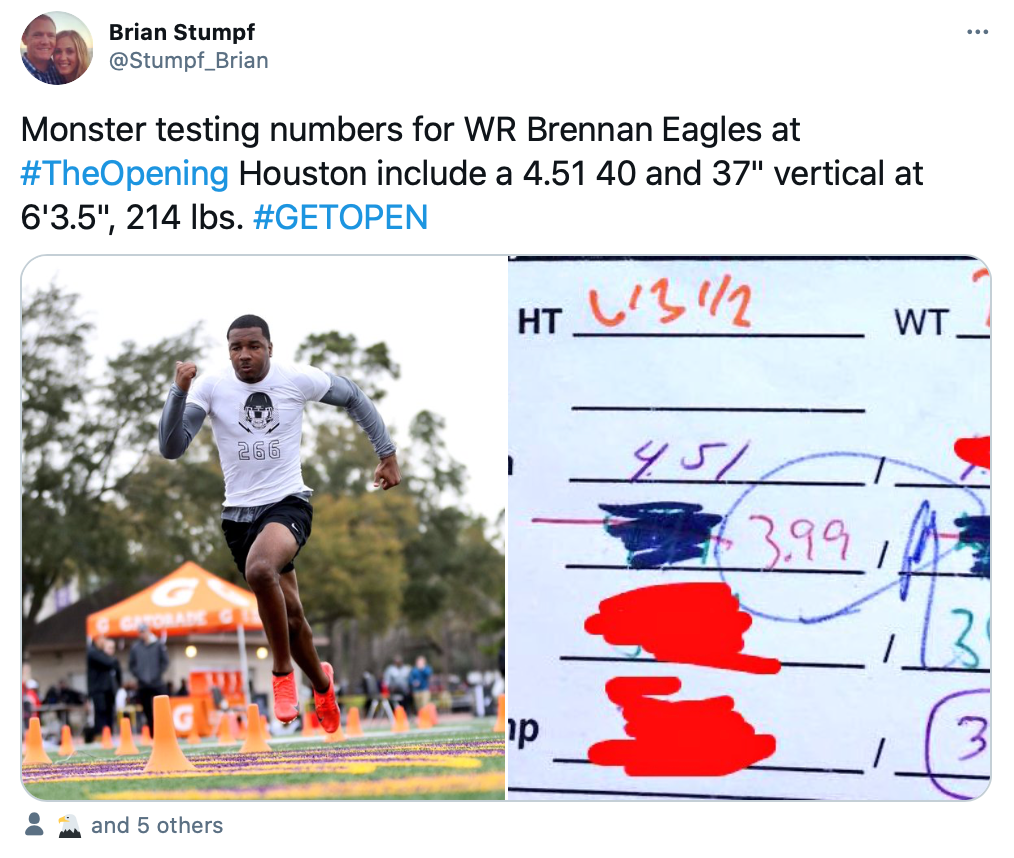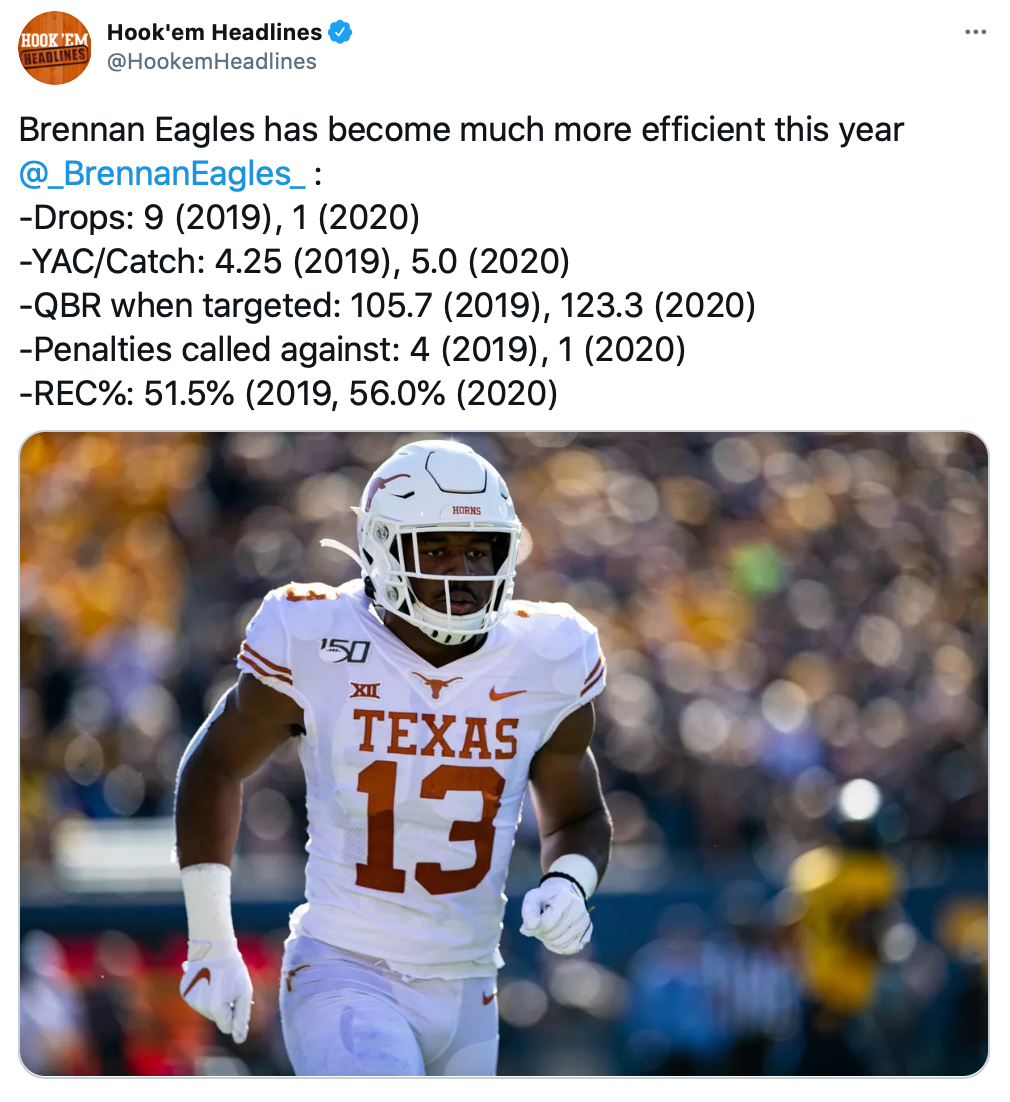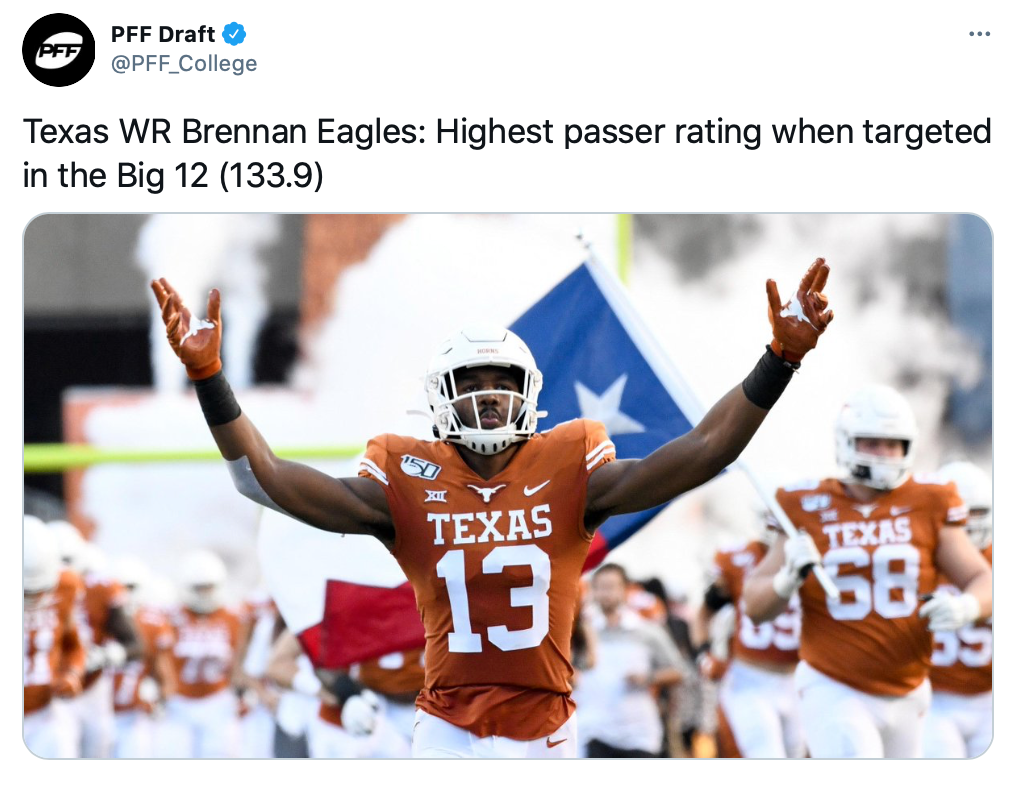Brennan Eagles
WR | Texas Longhorns | 6-4 | 225 lbs.
Rookie Expectations
Over the last three NFL seasons, wide receivers who predominantly lined up on the outside have run five particular routes for a combined total of three-fourths of routes. Those five routes are Go’s, Hitches, Outs, Slants, and Crossers. For WRs playing from the slot, these five routes are also featured, at slightly altered percentages, for a nearly identical combined total. The final 25% will be distributed between Ins, Posts, Corners, some Screens, and the rest on exotic combo routes when split wide. For slot WRs, the majority of that 25% will go toward Screens and shallow work in the flat. Whenever I make references to “NFL routes” in these Dyno rookie profiles, those are the guidelines I am following.
The Story
Brennan Eagles’ football career got off to fast start after being introduced to the sport around the age of 12. He teamed up with Alabama WR Jaylen Waddle, another name you’ll hear called at the 2021 NFL Draft, on their middle school team where they did most of the scoring. The fact that he quickly acclimated to the game is no surprise since his brother, Greg, played LB for the Louisiana-Lafayette Ragin’ Cajuns. But it wasn’t until midway through his sophomore season at Alief Taylor High School that his maturation began to match his natural, otherworldly athleticism. A local Houston scout convinced Eagles to attend area football camps that brought immediate attention toward his abilities. The results on the field would follow during his junior year, collecting 55 receptions, 1,069 yards, and 15 TDs.
Eagles’ junior emergence would aid the Lions in jumping from a rank of 1,380 nationally, 167 in the state of Texas the previous season all the way up to 741, and 76. Alief Taylor HS has guided 13 former students toward NFL careers, but Eagles very nearly transferred to prep juggernaut IMG Academy, ranking within the top-10 nationally over the last five seasons, for his senior year. He decided against the move, with his loyalty to HC Brian Randle playing an integral role. Over his first four games during his senior season, Eagles averaged a 3.8/57.5/1 receiving line, and his team put together a 2-2 record. A lower-leg injury sidelined him for the remainder of that season. Alief Taylor would finish the season 1-3, plummeting to ranks of 3,374 nationally, and 393 in Texas.
Eagles’ play, athletic testing would still earn him a four-star ranking from ESPN (No. 17 overall WR), 247Sports (No. 10), and Rivals (No. 10). He would choose the Texas Longhorns from 28 scholarship offers from a list that also included Alabama, Ohio State, Clemson, LSU, Auburn, Georgia, Florida, USC, and Oklahoma.
The announcement that he would forego his senior season with Texas to enter the NFL draft is both understandable and unfortunate. Understandable in that Eagles didn’t actually commit to the Longhorns, he was devoted to HC Tom Herman. Eagles also has a very close friendship with QB Sam Ehlinger, having side-by-side lockers during his time in Austin. Herman was fired by AD Chris Del Conte on January 2nd, and Ehlinger declared for the draft the following day. Eagles was no doubt informed of these upcoming announcements when he declared for the draft less than two weeks prior. It’s unfortunate that he made the decision to jump to the next level since the scouting community and NFL teams alike have one of the smallest on-field samples of any ‘21 draft eligible player.
The Attributes
As Eagles was still rehabbing from the lower-leg injury that cut his senior season at Alief Taylor short, he still attended the Nike Opening in Houston, and the Finals in Oregon. Measuring in at 6-foot-3 ½, 214 pounds, Eagles was timed at 4.51 seconds in the 40-yard dash, a vertical jump of 37 inches, and 3.99 seconds in the short shuttle. Take some time to allow those impressive size-adjusted numbers to settle in. Should he test out with similar numbers or better at his Texas Pro Day, Eagles will end up being drafted within the first four rounds on athleticism alone. With only a single healthy season in HS playing a significant role and declaring for the draft after his true junior season, a poor showing at his Pro Day could also end up plummeting his stock.
Before we get too far ahead of ourselves in the judgment of Eagles, let’s begin with viewing hisultra-important junior season film from Alief Taylor HS. At the 0:25 mark, we can see Eagles utilizing his massive frame on a goal-to-go (G2G), End Zone Fade. His strong hands in plucking the ball away from the defender are immediately showcased. We have another 50-50 ball to the end zone as shown at 3:06.
Eagles’ straight-line speed is on display during the 9R/Go collected over-the-shoulder against Cover 4 at 0:44. We see the same result facing Cover 4 on the very next clip, but the CB is seen in man on Eagles opposite trips. As we’ll later see in his Texas film, Eagles’ bread-and-butter is clearly the deep ball. The right CB would’ve served himself better in forcing Eagles to the inside at 2:53, toward his single-high, Cover 1 safety help. We can already note how comfortable Eagles appears tracking down over-the-shoulder targets. Another example in man opposite trips, secondary showing Cover 4 is shown at 3:17. Eagles’ strong hands allow him to corral the 9B/Back Shoulder Go with excellent body control.
Our first example of a hitch route is shown at 1:07 in the video, with a second on a hook-and-ladder at 4:02. These quick hitches are often overlooked in importance. However, they result in the bloated reception numbers you see at the NFL level. With his impressive acceleration, Eagles must master the hitch in order to keep defenses honest for his deep stuff (i.e., 5:01 and 10:15). As you can see at 4:30, 6:26, 7:04, 9:18, and 11:28, the hitch is also an excellent pivot when multiple defenders drop deep into a zone. At 2:45 in the red zone, Eagles fights through the tight man coverage on a slant, another important NFL route, toward the end zone. Further examples can be found at 6:49, 7:12, and 7:42. Unfortunately, a lack of slant experience could cost him some snaps in the future.
We have some very early, intriguing examples of Eagles’ blocking ability. His assignments on Jet Sweeps (3:43 and 10:04) and in blocking for the run (11:20) are clearly overwhelmed by at least 40-pound weight differences. On the wide screen at 4:39, Eagles is doing well setting the edge at the second-level. With his frame, Eagles will always have the option of adding a few pounds to test the waters at TE should his NFL career at WR fizzle out. An area of his game that can immediately be expected to be utilized is on special teams. Eagles was a key member of the Longhorns’ special teams unit, the majority with blocking responsibilities. We have a clip of him returning a punt at 3:50 and blocking on the kick return unit at 5:46 and 6:32.
We’ll jump ahead to his true sophomore season at Texas since he missed the majority of his senior season of HS due to injury, and was limited to special teams his true freshman season in Austin. Unfortunately, no highlight reels of Eagles’ true junior season have been uploaded. Rather than linking several different files, I will simply pass along my notes from watching the individual game tapes. So, the following breakdown of his true sophomore tape will be your only chance to watch college film while reading my analysis.
The first play will technically fall just short of the crossing route definition, but does offer an example similar to the important NFL route completely missing in his HS film. It’s also one of the three TDs scored facing Group of Five defenses out of only 11 career TDs. And we have another TD on a coverage bust from the Louisiana Tech game at 0:29. It’s entirely understandable that these smaller conference teams earn such a large portion of their budget scheduling games against Power Five opponents. And many individuals from Group of Five or FCS schools have certainly proved themselves in the NFL. But the reliability from using film from these matchups in projecting player upside is diminished.
Let’s focus first on Eagles defended by Power Five man coverage. We know the Back Shoulder Go example at 0:51 opposed by LSU CB Cordale Flott at 0:51 stands as a challenging counterpart. Our second example facing man coverage is a slant at 2:09 defended by talented Oklahoma CB Tre Brown. In the red zone facing Kansas at 2:46, Eagles does a nice job blocking the defender out on the slant. At the 4:40 mark, Eagles showcases his strong hands adjusting to the high throw on another slant. Solid examples on slants, but Eagles would only run the pattern on 6% of career routes, and less than half the number his NFL team will expect in Year 1.
Now we’ll turn our attention to Eagles versus zone coverages. At 1:18 of the LSU game, we have another Back Shoulder Go where he highpoints the ball for a 55-yard TD, defended by former four-star CB Eli Ricks in a Cover 4 zone. The long TD at 1:50 against Oklahoma State is certainly eye candy, but this is another massive coverage bust. Eagles and Tre Brown meet again on a hitch at 2:21, this time with the Sooners in Cover 4. Like most college WRs moving to the NFL game, Eagles will have his work cut out for him adjusting to facing Cover 3 zones. The play at 3:54 is one of his finest examples facing Cover 3, on a rare crossing route, no less.
Eagles displayed considerable growth in several areas of his game during the ‘20 season. The most substantial gain was made while facing man coverage. We’ve seen that Eagles is more than comfortable having defenders body him up, so I feel the appearance of additional muscle in his frame can explain some of his massive 79% increase in per route yardage production over the previous season. Eagles also had the opportunity to add snaps facing Cover 3. With the middle of the field closed by this coverage, Eagles utilized slants (i.e., facing Kansas State), hitches, and another impressive deep Go down the right sideline against Iowa State facing the three-deep zone shell.
Dealing with so much competition for touches throughout his time in a talented Texas WR room, earning more trust from his coaches and QB was monumental. So, we can also direct some of the added involvement/production in that direction. Eagles had already overtaken Tarik Black as the Longhorns’ starting Split End/X when he scored a TD in Week 5 facing TCU for three straight to begin the season. With Jake Smith dealing with injuries and COVID protocols, Eagles became one of Ehlinger’s go-to targets alongside Joshua Moore. He will no doubt hope the senior tape of his NFL routes will be enough to dispel the limited label of a deep threat. But Eagles would still end up scoring four-of-five TDs on targets travelling 20-plus yards.
Fantasy Fit
The first matter of business for Eagles will be cementing the athletic measurements as a teenager as legitimate during his Pro Day. If that testing holds up at his size, there’s no telling how high he could move up. Within my evaluation process, I always give serious reservation toward trusting my draft capital on WRs with limited college production. What we do have from Eagles is explosive playmaking, but everything is still going to center around his Texas Pro Day.
It would be foolish to comp Eagles alongside elite college WRs based on his size and athleticism without anything close to their accompanying production (i.e., Michael Pittman Jr.). In my mind, he brings to mind a profile similar to that of Miles Boykin. We really only have considerable evidence of Eagles excelling on Go’s and Hitches. His work on Crossers is promising, not to be forgotten, but we have very little on Slants and Outs to envision him receiving a significant role early in his career.
The Bottom Line
Eagles brought loads of promise into his college career. Holes in his game could/likely would have been addressed during his senior year with Texas. Neither here nor there, we have what we have. We just don’t have enough information at this point to avoid thinking Eagles is unlikely to earn many starts, profiling as a situational deep threat on obvious passing downs, and special teamer over his first couple seasons. This kid is a physical specimen in the mold of DK Metcalf. His 3.99 second short shuttle also blows away Metcalf’s 4.50 Combine time. We can already state his change of direction is superior to DK’s. But Metcalf’s 4.33 40 time would run circles around Eagles’ 4.51.
What does it all mean? At this stage, the risk averse approach would be assuming Eagles will require additional seasoning before earning significant playing time. Eagles could end up following a similar career path in the NFL as Tyron Johnson. Tons of potential, lacking in opportunity, and ultimately taking until nearly his Age 25 season before receiving meaningful snaps. Do not get the impression that Eagles is without Dyno value with his rare collection of athleticism. If he runs in the low 4.4’s with the same peripheral measurements, he could also jump all the way to being a first-round selection. If he ends up standing on the sidelines for too long, it may end up being difficult keeping him rostered out of such a stacked WR class… unless he truly sets the world ablaze during his Pro Day, of course.











